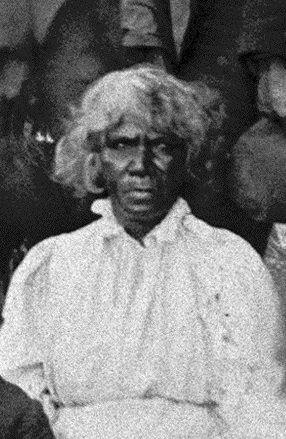Written by Elizabeth Heffernan, RAHS Volunteer
To celebrate Women’s History Month in 2020, the Royal Australian Historical Society will continue our work from last year to highlight Australian women that have contributed to our history in various and meaningful ways. You can browse the women featured on our webpage, Women’s History Month.
Aboriginal and Torres Strait Islander people are advised that this webpage contains the images and names of people who have passed away.
In 2006, the Federal Court of Australia ruled that the Noongar people held Native Title rights over the city of Perth and its surrounds. This marked the first acknowledgment of Native Title in an Australian capital city. Without the contributions of land activist and Noongar woman Fanny Balbuk more than a century earlier, such a significant decision may never have been made. [1]
Fanny grew up in Matagarup, now known as Heirisson Island, in the fledgling Swan River colony, and was a descendant of Whadjuk Noongar leader and ‘King of Perth’ Yellagonga, who died in 1843. [2] Raised within her traditional culture, Fanny had likely never seen a house until the nearby Perth settlement began to grow. As a child, she spent her time gathering “the scarlet fruit of the zamia in its season … the many roots and fruits growing on the slopes of Karr’gata.” [3] She would do so along the same walking track, the bidi, into adulthood. For Noongar elder Noel Nannup, “That was her songline, her dreaming.” [4]

Fanny Balbuk Yooreel [Image courtesy State Library of Western Australia]
Anthropologist Daisy Bates took a keen interest in Fanny and her activities. Through Fanny, she studied the Noongar people, eventually publishing her findings in her 1938 book The Passing of the Aborigines. Though much of the work is today considered highly inappropriate and paternalistic, Bates’ book did help secure the Noongar Native Title claim in 2006. By extension, so did Fanny. [7]
In 2017, for the hundred-and-tenth anniversary of Fanny’s death, the city of Perth partnered with the National Trust of Western Australia to honour her life. It included the publication of a walking trail brochure along the same path taken by Fanny all those years ago. [8]
Standing at a little over five feet and yet with the presence of a giant, Fanny was an incomparable and unforgettable figure in the history of Western Australia and the Aboriginal land rights movement. Upon hearing of her death, Fanny’s relatives uttered the phrase “goord-al-winja-ga.” Bates translated this as “her heart has ceased to heat.” [9] Fanny’s fire, her passion, and her determination carried her through her life, and went on to carry her legacy far beyond her lifetime. Wadjuk Ballardong elder Marie Taylor put it best: “People thought that she was a mischievous young woman … I have found she was a Noongar woman dedicated to her culture.” [10]
References:
[2] ‘Death of the King of Perth’, Perth Gazette and Western Australian Journal, 10 June 1843, 2, <https://trove.nla.gov.au/newspaper/article/644356>, accessed 19 February 2020.
[3] Daisy M. Bates, ‘FANNY BALBUK-YOOREEL: THE LAST SWAN RIVER (FEMALE) NATIVE’, Western Mail, 1 June 1907, 44, <https://trove.nla.gov.au/newspaper/article/37393844>, accessed 19 February 2020.
[4] Leonard Collard and Tod Jones, ‘Fighting for families, country, rights and recognition: Aboriginal Heritage in the City of Perth after 1829’, City of Perth, <https://visitperth.com/-/media/Project/COP/COP/COP/Documents-and-Forms/Visit-Perth/Documents/Maps-and-Visitor-Guides/Fighting-for-families-country-rights-and-recognition.pdf>, accessed 19 February 2020.
[5] Collard and Jones, ‘Fighitng for families’.
[6] ‘Fanny Balbuk’, Western Australian Museum, <http://museum.wa.gov.au/explore/wetlands/aboriginal-context/fanny-balbuk>, accessed 19 February 2020.
[7] ‘FANNY BALBUL YOOREEL’.
[8] ‘Aboriginal culture’, City of Perth, <https://www.visitperth.com.au/getting-around/indigenous-culture>, accessed 19 February 2020.
[9] Bates, ‘FANNY BALBUK-YOOREEL’.
[10] Emma Wynne, ‘Fanny Balbuk Yooreel, the Aboriginal land activist you’ve probably never heard of’, ABC News, 19 May 2017, <https://www.abc.net.au/news/2017-05-19/celebrating-fanny-balbuk-yooreel-110-years-later/8538688>, accessed 19 February 2020.
